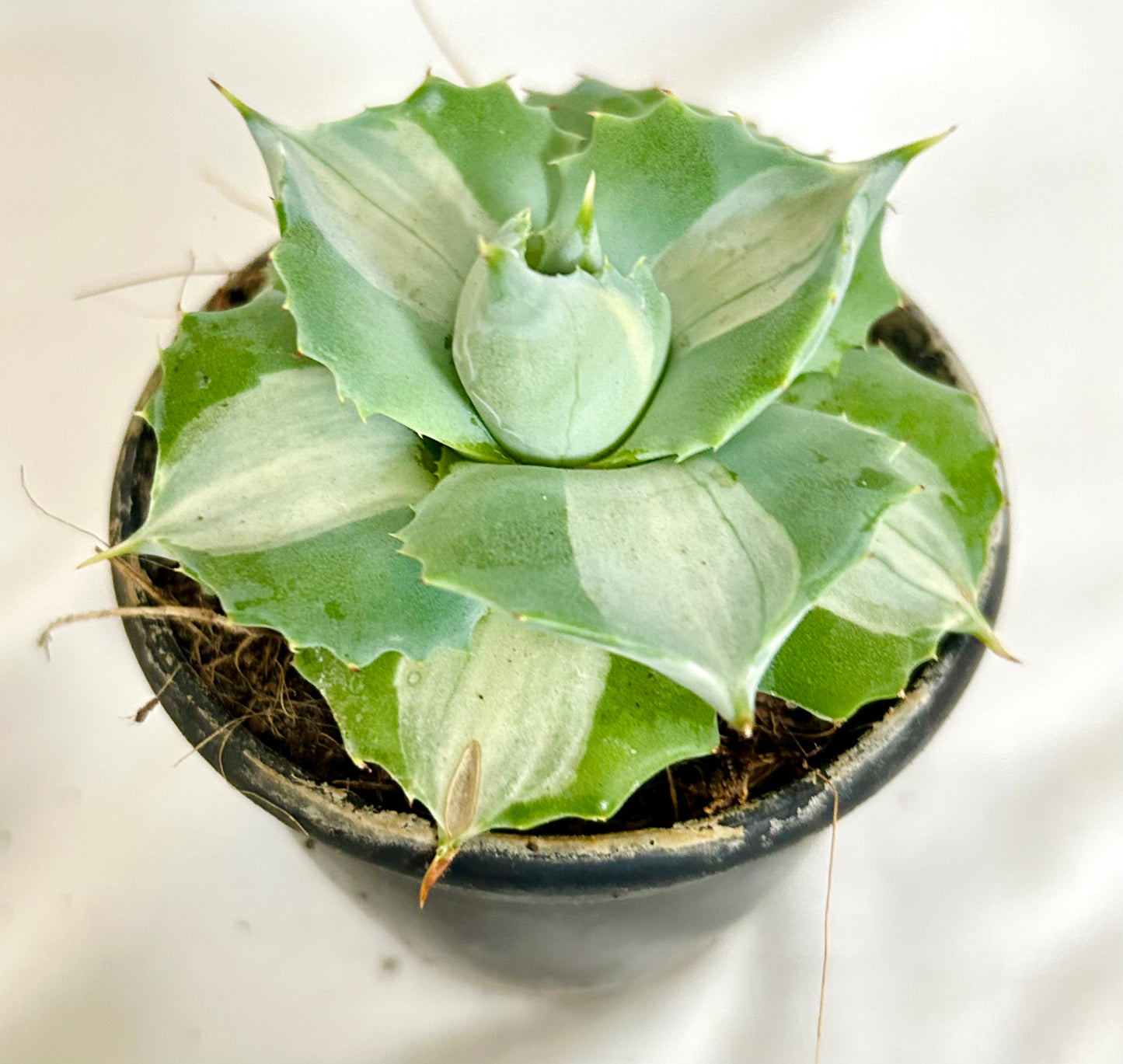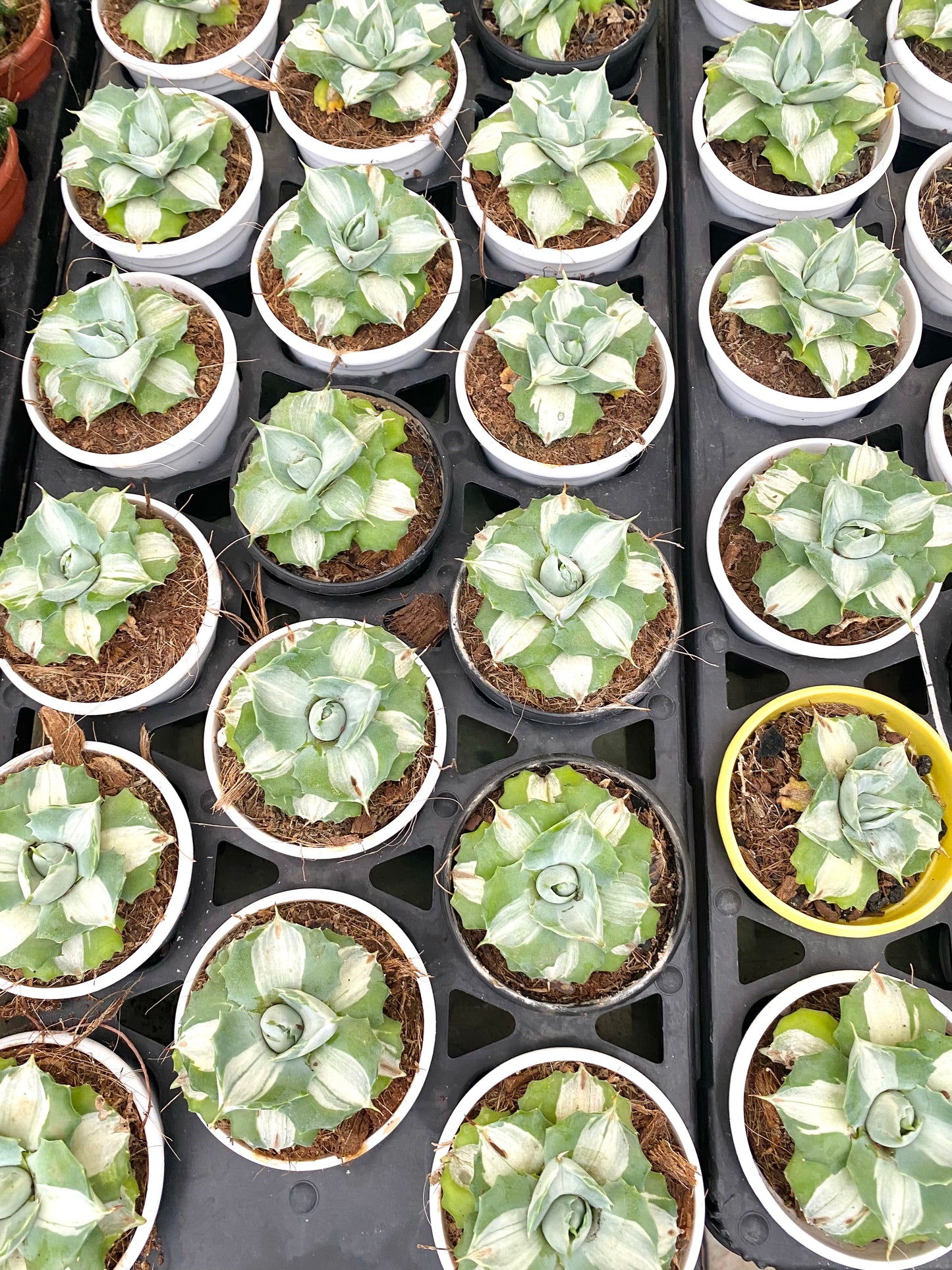vendor-unknown
Agave Isthmensis Mediopicta
Agave Isthmensis Mediopicta
Couldn't load pickup availability
PRODUCT SPECIFICATIONS
|
Plant |
Agave isthmensis 'Mediopicta' |
|
Pot Height |
4” |
|
Pot Diameter |
4” |
|
Plant Height |
6"-10" |
|
Growing Medium |
Soilless Cocopeat NPK medium |
|
Product Weight |
250 grams |
KNOW YOUR PLANT
Agave isthmensis 'Mediopicta' is a variety of agave known for its attractive appearance. It's a succulent plant native to Mexico.
This variety is characterized by its compact rosette of blue-green leaves with a creamy-white central stripe, creating a distinctive and appealing visual contrast. Like other agave species, it thrives in well-draining soil and requires plenty of sunlight.
Agave isthmensis 'Mediopicta' is a popular choice among succulent enthusiasts and is often grown in containers or used as an ornamental plant in gardens and landscapes.
PLANT CARE
- Sunlight: Agave plants thrive in full to partial sunlight. Place your agave where it receives at least 6 hours of direct sunlight each day. In hotter climates, partial shade during the hottest part of the day may be beneficial.
- Well-Draining Soil: Use well-draining soil to prevent root rot. A cactus or succulent mix is suitable, or you can amend regular potting soil with sand or perlite to improve drainage.
- Watering: Agaves are drought-tolerant and prefer to dry out between waterings. Water sparingly, allowing the soil to dry completely before watering again. In the growing season (spring and summer), water every 2-4 weeks, and reduce watering in the winter.
- Pot or Container: If you’re growing an agave in a container, make sure the pot has drainage holes to prevent water from accumulating at the bottom.
- Fertilizing: Agave plants generally don’t require frequent fertilization. You can apply a diluted, balanced, liquid fertilizer during the growing season (spring and summer) once a month or less.
- Pruning: Remove dead or damaged leaves as needed to maintain the plant’s appearance. Be cautious of the sharp leaf tips when pruning.
- Pests and Diseases: Agaves are relatively resistant to pests and diseases. However, watch for signs of scale insects or mealybugs and treat them promptly if detected.
- Protection from Frost: Agaves are generally not frost-tolerant. If you live in a region with cold winters, bring potted agaves indoors or provide frost protection in the form of blankets or frost cloth.
- Propagation: Agaves can be propagated by offsets (pups) that grow at the base of the mother plant. Carefully remove these offsets and replant them in well-draining soil.
- Space: Ensure adequate spacing between agave plants, as they can grow quite large, and their rosettes need room to expand.
Remember that agaves are slow growers and may take several years to reach their mature size and full beauty. With the right care and attention to their specific needs, agave plants can be a stunning and low-maintenance addition to your garden or landscape.
BENIFITS
- Ornamental Value: Agave is prized for its striking appearance with variegated leaves. It can serve as an eye-catching focal point in gardens or landscapes due to its unique coloration and architectural form.
- Drought Tolerance: Agaves are well-suited for arid and dry climates. They can withstand prolonged periods of drought and require minimal watering, making them an excellent choice for water-conservation and xeriscaping.
- Low Maintenance: These succulents are relatively low-maintenance. They don’t require frequent pruning or special care, making them an easy addition to gardens for those who prefer low-effort gardening.
- Wildlife Habitat: Agave flowers can attract pollinators like bees and hummingbirds, contributing to local ecosystem health.
- Decorative Use: The leaves of agave plants are sometimes used for decorative purposes in crafts and floral arrangements.
- Succulent Diversity: Agaves are part of the diverse world of succulent plants, which are popular for their unique textures, shapes, and colors.
It’s worth noting that while agaves have these benefits, they also have sharp spines on their leaf tips, so care should be taken when handling them. Additionally, they may not be suitable for households with pets or small children due to these sharp points.
USEFUL TIPS
- Select the Right Location: Choose a sunny spot in your garden or landscape with well-draining soil. Agaves love sunlight, so a location with at least 6 hours of direct sun per day is ideal.
- Well-Draining Soil: Ensure the soil is well-draining to prevent waterlogged roots, which can lead to root rot. Sandy or gravelly soil is typically suitable, or you can amend your soil with sand or perlite.
- Planting Depth: When planting agaves, make sure the crown (the central part of the plant where the leaves emerge) is at or just above the soil level. Planting too deeply can promote rot.
- Spacing: Give agave plants enough space between them to accommodate their mature size. These plants can grow quite large and need room to spread their rosettes.
- Watering: Water sparingly. Let the soil dry out completely between waterings. During the growing season (spring and summer), water every 2-4 weeks. Reduce watering in the winter. Overwatering is a common mistake that can harm agaves.
- Protection from Frost: Agaves are generally not cold-hardy and can be damaged by frost. If you live in an area with cold winters, take precautions to protect your agave plants from freezing temperatures.
- Fertilizing: Agaves typically don’t require frequent fertilization. If your soil is poor, you can apply a balanced, diluted liquid fertilizer during the growing season (spring and summer) once a month or less.
- Pruning: Remove dead or damaged leaves as needed. Be cautious of the sharp leaf tips, and use gloves when pruning.
- Pest and Disease Management: Agaves are relatively resistant to pests and diseases. However, inspect your plants regularly for signs of scale insects, mealybugs, or other issues, and treat them promptly if detected.
- Propagation: If you want to propagate agaves, look for offsets (pups) that grow at the base of mature plants. Carefully separate these offsets and replant them in well-draining soil to establish new plants.
- Container Gardening: If you’re growing agaves in pots or containers, ensure the pots have drainage holes to prevent water accumulation. Container-grown agaves can be brought indoors during cold weather.
- Patience: Agave plants are slow growers and may take several years to reach their full size and beauty. Be patient and enjoy the journey.
By following these tips and providing the right care, you can successfully cultivate and enjoy healthy agave plants in your garden or landscape
COMMON PROBLEMS AND SOLUTIONS:
- Overwatering: One of the most common problems is overwatering. Agaves prefer well-draining soil and should be allowed to dry out between waterings. Solution: Reduce the frequency of watering and make sure the soil dries out completely between waterings.
- Root Rot: Overwatering can lead to root rot, a fungal disease that affects the plant’s roots. Signs of root rot include yellowing and wilting leaves. Solution: If caught early, remove the infected parts and improve drainage. In severe cases, it may be necessary to replant in well-draining soil.
- Pests: Agaves are typically resistant to most pests, but they can sometimes be attacked by scale insects, mealybugs, or aphids. Solution: Treat the affected areas with insecticidal soap or neem oil and remove the pests manually if possible.
- Disease: While agaves are relatively disease-resistant, they can occasionally develop fungal diseases like leaf spot. Solution: Prune and dispose of affected leaves, and avoid overhead watering, which can spread fungal spores.
- Freezing Temperatures: Agaves are not frost-tolerant. Cold temperatures can damage or kill the plant. Solution: In areas with frosty winters, provide protection for your agaves by covering them with frost cloth or moving potted agaves indoors.
- Pest Birds: Birds may be attracted to agave flowers and can damage them. Solution: Use bird netting or other deterrents to protect the flowering stalks.
- Offset Removal: When removing offsets (pups) for propagation, it’s essential to do it correctly to avoid damaging the mother plant. Solution: Use a clean, sharp knife or spade to separate offsets from the main plant, making clean cuts.
- Leaf Damage: Agave leaves can be damaged by various factors, including accidental pruning, mechanical injury, or herbivores. Solution: Keep the plant in a location where it’s less likely to be bumped or damaged, and be cautious when working near agave plants.
- Yellowing Leaves: Yellowing leaves can be a sign of both overwatering and underwatering. Solution: Adjust your watering routine based on the specific needs of your agave and the local climate.
- Inadequate Sunlight: If an agave doesn’t receive enough sunlight, it may become leggy and have weaker leaves. Solution: Ensure your agave gets the required amount of sunlight, at least 6 hours of direct sun per day.
By monitoring your agave plants and addressing issues promptly, you can keep them healthy and thriving in your garden or landscape.
HAPPY PLANT PARENTING!!
Disclaimer: Actual plant may have slight variations from what is shown in the image since each individual plant has its own appearance.
Share







